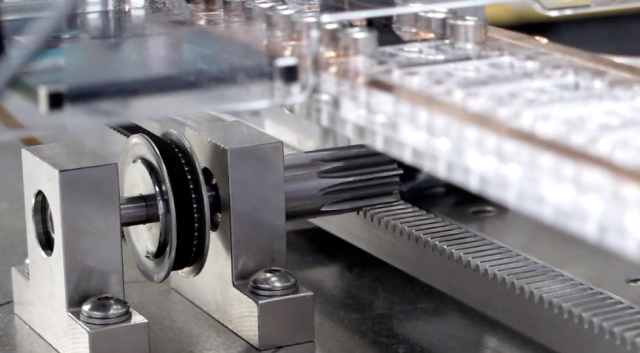Mechanical computer flexes its muscle (original) (raw)
Science —
A step back to mechanical computers and a step forward to artificial muscles.

Not just any old machine—a Turing machine.
If we go way back to the 18th century, we find ourselves in the heyday of mechanics. Indeed, many physicists believed that the world was essentially mechanical and deterministic. More importantly, everyone was thinking about mechanical solutions to problems. In that milieu, it seemed natural to think of computing in terms of gears, chains, sprockets, and cams. The result was mechanical computers.
Once the electronics revolution hit full stride, these machines ended up being remembered as the pinnacle of a bygone age. Now, in a blast from the past, a pair of researchers from New Zealand have demonstrated an updated version of the mechanical computer: an artificial, muscle-based computer. It's slow and bulky, and it can't do a lot, but the researchers argue that it has great potential for robotics.
To implement their computer, the researchers returned to the original work of Alan Turing, who envisioned a computer as a read-write head that operated on a linear tape. The write operations depend on the results of read operations and whatever program might be in memory. This machine can, in principle, solve any problem that is solvable by a computer and is known as a universal Turing machine, of which modern computers are an example.
It turns out that the simplest form of a universal Turing machine is very simple indeed. It reads only three different states (A, B, and C), it has only two internal states (logics one and zero), and it can move the tape either left or right. Such a simple machine has only six possible operations. For example, if it reads an A and its internal state is logic one, then it will overwrite the A with a B, flip its internal state, and move one step to the right. Such a computer is very simple, but programming it is very, very complicated—even simple operations, like multiplication, involve elaborate programs and long run times.
The benefit is that building one of these machines is very simple, and therefore perfect for implementing in a mechanical system. The researchers made their computer out of a set of elastomers—elastomers are polymers that expand or contract when a voltage is applied. These artificial muscles were set up so that they could operate sets of electrical relays that drove other muscles. The tape in this computer was pulled left and right by a set of weights that were controlled by a cam system, actuated by yet another muscle. Once constructed, the researchers checked the output against hand calculations of the computer's output.
And it worked. The device came in at a svelte 0.3 cubic meters and its computational speed was a massive 0.15Hz. It lacks the tape capacity to calculate anything complicated, but in principle it can calculate anything. There is a video (MOV) available to view it in action.
Nostalgia is all well and good, but there must have been a useful reason to do this, right? Indeed there may well be: better robots. One of the interesting things about living things is the way they can react before they have time to think. For instance, a Formula 1 driver starts reacting to, say, their car losing grip before you would expect them to if the brain were participating. In fact, the animal kingdom is chock-full of reflexive systems, where muscles react without the participation of a brain.
This sort of local computation is simple, fast, and may be built right into the muscle's local nerves. But like all autonomous actions, it requires more than local computers and actuators—it needs feedback. That feedback is rather nonlinear for muscles; an example of this is pain. Place your hand above a hot element, and you feel the heat. Touch it, and your muscle spasms, pulling your hand away. A robot that effectively makes use of local reflexive computation will likely require a fast, nonlinear feedback system, which can be naturally built into muscles, but not into normal actuators.
This work, the researchers argue, is a starting point for making muscles that can think for themselves. From my point of view, the robotics was entirely incidental. How cool is a mechanical computer? And to make the paper even more old school, the diagrams were hand-drawn. I think I need to lie down.
Applied Physics Letters, 2013, DOI: 10.1063/1.4793648 (About DOIs).